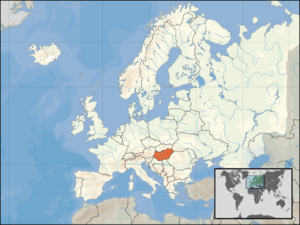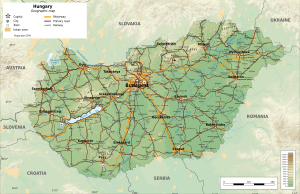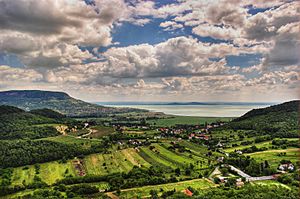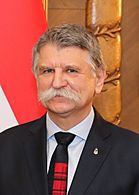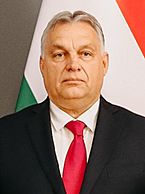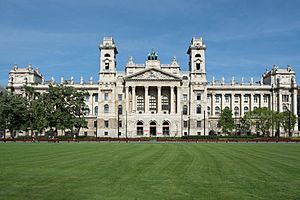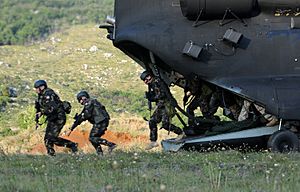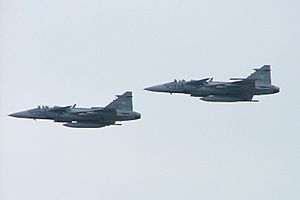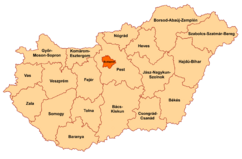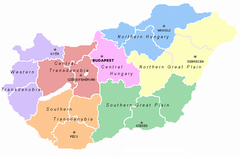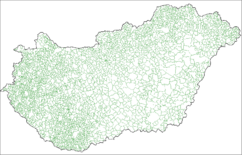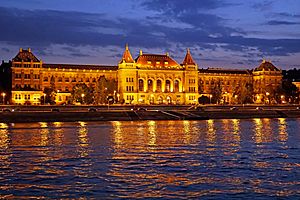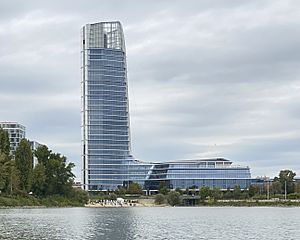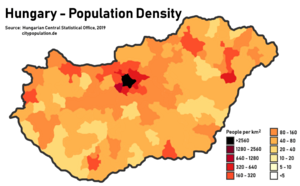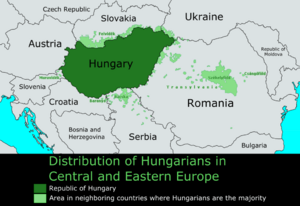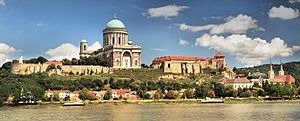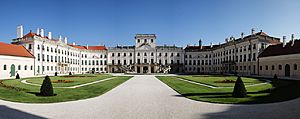Hungary facts for kids
Quick facts for kids
Hungary
Magyarország (Hungarian)
|
|
|---|---|
![Location of Hungary (dark green)– on the European continent (green & dark grey)– in the European Union (green) — [Legend]](/images/thumb/6/60/EU-Hungary.svg/350px-EU-Hungary.svg.png)
Location of Hungary (dark green)
– on the European continent (green & dark grey) |
|
| Capital and largest city
|
Budapest 47°26′N 19°15′E / 47.433°N 19.250°E |
| Official languages | Hungarian |
| Ethnic groups
(2022 census)
|
|
| Religion
(2022 census)
|
|
| Demonym(s) | Hungarian |
| Government | Unitary parliamentary republic |
| Tamás Sulyok | |
| Viktor Orbán | |
|
• Speaker
|
László Kövér |
| Legislature | National Assembly |
| Foundation | |
|
• Principality of Hungary
|
895 |
| 25 December 1000 | |
| 24 April 1222 | |
| 29 August 1526 | |
|
• Liberation of Buda
|
2 September 1686 |
|
• Revolution of 1848
|
15 March 1848 |
| 30 March 1867 | |
| 4 June 1920 | |
| 23 October 1989 | |
| Area | |
|
• Total
|
93,030 km2 (35,920 sq mi) (108th) |
|
• Water (%)
|
3.7 |
| Population | |
|
• January 2024 estimate
|
9,584,627 (95th) |
|
• 2022 census
|
9,603,634 |
|
• Density
|
103/km2 (266.8/sq mi) (78th) |
| GDP (PPP) | 2024 estimate |
|
• Total
|
|
|
• Per capita
|
|
| GDP (nominal) | 2024 estimate |
|
• Total
|
|
|
• Per capita
|
|
| Gini (2023) | ▲ 29.0 low |
| HDI (2022) | very high · 47th |
| Currency | Forint (HUF) |
| Time zone | UTC+1 (CET) |
|
• Summer (DST)
|
UTC+2 (CEST) |
| Date format | yyyy. mm. dd. |
| Driving side | right |
| Calling code | +36 |
| ISO 3166 code | HU |
| Internet TLD | .hu |
|
|
Hungary is a country in Central Europe. Its capital city is Budapest. Hungary is a bit larger than its western neighbor Austria. It has about 10 million people living there. Other countries that border Hungary are Slovakia, Ukraine, Romania, Serbia, Croatia and Slovenia.
The official language of Hungary is Hungarian. Hungary has been a member of the European Union (EU) since 2004. In Hungarian, the country is called Magyarország. This means "Hungarian country". It is named after the Magyar tribes who arrived in Hungary in the late 9th century.
Contents
Hungary's Past: A Journey Through Time
Early History: From Tribes to Kingdom (896-1526)
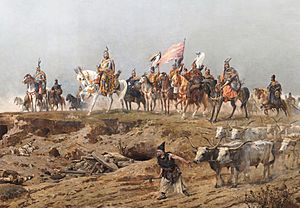
The Magyars created Hungary in 896. They came from their lands in Eastern Europe. Prince Árpád was their leader. He also started the first royal family of the country, the Árpád-house. In 1000, the country became a Kingdom. This happened after the first king, Saint Stephen, was crowned.
In 1241, the Mongol Empire attacked Hungary. King Béla IV had to run away. About 500,000 Hungarians died, and there was a lot of damage. In 1301, the Árpád-house ended. Later, kings from different families ruled Hungary. One of the most famous was Matthias Corvinus. He was known for taking lands like Vienna from Austria. He also protected Hungary from the Ottoman Empire.
However, after he died in 1490, the Ottoman Sultan Suleiman the Magnificent defeated the Hungarian king. This happened in the Battle of Mohács in 1526. The Kingdom was then split into three parts. The western and northern areas stayed Hungary. The southern part fell under Ottoman rule. The eastern part became a state under the Ottomans, called the Principality of Transylvania.
Hungary Between 1526 and 1867
The Kingdom of Hungary became part of the Habsburg family's lands. This was due to an agreement made in Vienna in 1515. It said that the Habsburgs would take over the lands of the Jagellion family in Bohemia and Hungary if their kings had no heirs. In 1686, the Ottomans were forced to leave. The country was reunited. Many different groups of people lived in Hungary at this time. Besides Hungarians, there were also ancestors of today's Slovaks, Serbs, and Romanians.
In 1703, Francis II Rákóczi, a Hungarian nobleman, started a revolution. He led it against the Habsburgs because Hungarians were not happy with them. But his revolution failed in 1711, and he had to go into exile. The next big event was the "Hungarian Revolution of 1848". The people of Hungary rebelled again. The fighting ended in 1849, with the Habsburgs winning. The leaders of the revolution were executed.
Austria-Hungary: A New Partnership (1867-1918)
Hungary looked for a way to become stable. In 1867, Austria and Hungary, the two most important Habsburg lands, signed a treaty. They formed the Austro-Hungarian Monarchy. This new setup worked well for both sides. The agreement brought a lot of economic growth.
Between the World Wars (1918-1946)
After losing World War I in 1918, the Kingdom was ended. A republic was created because people were tired of war. This republic did not last long. Soon, the Communists took power in 1919. During their rule, many people were treated badly. This included farmers and educated people. The Communists had to leave when Romanian troops invaded.
In late 1919, Hungarian forces, led by Admiral Miklós Horthy, took over Budapest. To respond to the communist actions, they started the "White Terror". They treated communists and their supporters badly. The kingdom was brought back, but there was no king. Horthy was chosen as the country's regent. The assembly decided not to bring back the Habsburg family.
Hungary lost the war. Because of the Treaty of Trianon in 1920, Hungary lost two-thirds of its land. In most of these areas, non-Hungarians were the majority. However, many Hungarians also found themselves living outside their country. They were in the new countries of Romanians or Slovaks. So, the main goal of Horthy's governments was to change this treaty. They wanted to get back the lands where Hungarians lived.
Communist Hungary (1946-1989)
After Nazi Germany fell, Soviet troops took over all of Hungary. Hungary slowly became a communist state controlled by the Soviet Union. After 1948, Communist leader Mátyás Rákosi set up a strict Stalinist rule. He forced farmers to join collective farms. He also created a planned economy. This led to the Hungarian Revolution of 1956. Hungary tried to leave the Warsaw Pact. But the Soviets sent in over 150,000 soldiers and 2,500 tanks. Almost 250,000 people left the country when the borders were open for a short time in 1956. János Kádár became the leader of the communist party. In 1991, Soviet soldiers left Hungary. The country then started to change to a market economy.
Modern Hungary: A Republic Since 1989
Today, Hungary is a democratic republic. People vote in elections every four years.
Hungary's Landscape and Weather
Hungary is a landlocked country. This means it has no coast or access to the sea. Its geography is shaped by two main rivers: the Danube and Tisza. The country is often divided into three parts based on these rivers. These parts are Dunántúl (west of the Danube), Tiszántúl (east of the Tisza), and Duna-Tisza kőze (between the Danube and Tisza). The Danube flows from north to south through the middle of Hungary. The whole country is within its drainage basin.
Dunántúl, west of the country's center, is mostly hilly. It has low mountains like the eastern Alps (Alpokalja) in the west. Also, the Transdanubian Mountains are in the central part of Dunántúl. The Mecsek Mountains and Villány Mountains are in the south. The highest point in this area is Írott-kő, which is 882 meters (2,894 feet) high. The Little Hungarian Plain (Kisalföld) is in northern Dunántúl. Lake Balaton, the largest lake in Central Europe, is also here. So is Lake Hévíz, the world's largest thermal lake.
The Duna-Tisza kőze and Tiszántúl areas are mostly flat. They are part of the Great Hungarian Plain (Alföld). This plain covers most of eastern and southeastern Hungary. To the north of the plain are the foothills of the Carpathian Mountains. They form a wide band near the Slovakian border. Kékes is the tallest mountain in Hungary. It is 1,014 meters (3,327 feet) high and found in this area.
Hungary has 10 national parks. It also has 145 smaller nature reserves and 35 areas protected for their landscapes.
What is Hungary's Climate Like?
Hungary has a temperate climate with four seasons. Summers are generally warm with low humidity but often have rain showers. Winters are cold and snowy. The average yearly temperature is 9.7°C (49.5°F). Temperatures can reach 41.9°C (107.4°F) in summer and -35°C (-31°F) in winter. The average high temperature in summer is 23 to 28°C (73 to 82°F). The average low temperature in winter is -3 to -7°C (27 to 19°F). The average yearly rainfall is about 600 mm (24 inches).
How Hungary is Governed
Hungary is a unitary parliamentary republic. This means it has one central government. The country's political system follows rules set in 2012. These rules are in the Fundamental Law of Hungary. Changes to this law usually need two-thirds of the parliament to agree. The basic ideas of the constitution, like human dignity and the rule of law, last forever.
There are 199 Members of Parliament. They are elected to the Országgyűlés (National Assembly). This is the highest government body. Elections happen every four years. People vote for one winner in each area. A party needs at least 5% of the votes to get seats.
The President of the Republic is the head of state. The National Assembly elects the president every five years. The president mainly has duties like meeting foreign leaders. They also formally suggest the prime minister. The president is also the leader of the armed forces. An important power of the president is to stop laws. They can send laws to the Constitutional Court for review. The third most important job is the Speaker of the National Assembly. This person is chosen by the National Assembly. They are in charge of the daily meetings.
The prime minister is chosen by the National Assembly. They are the head of government. They have the power to run the country. Usually, the prime minister is the leader of the biggest party in parliament. The prime minister chooses the Cabinet ministers. They can also fire them. But new ministers must have public hearings and be approved by the National Assembly and the president. The Cabinet reports to Parliament.
Laws and Courts in Hungary
Hungary's legal system is a civil law system. This means laws are written down in codes. It is like German law and Roman law. The court system has two main parts. One handles regular civil and criminal cases. The other handles cases between people and the government.
The courts for civil and criminal cases are:
- Local courts (járásbíróság)
- Regional appeal courts (ítélőtábla)
- The supreme court (Kúria)
Hungary's highest courts are in Budapest.
Law enforcement in Hungary is handled by the police and the National Tax and Customs Administration. The Hungarian Police is the main police force. They do most police duties. This includes solving crimes, patrolling, and traffic control. They also control borders. The national police commissioner leads them. This person works under the Minister of the Interior. The police are divided into county, regional, and town departments.
The National Police has special groups. The "Nemzeti Nyomozó Iroda" is a civilian police force. They investigate serious crimes. The "Készenléti rendőrség" is a military-like police force. They deal with riots and help local police. In 2008, the police and border guards joined together. This happened because Hungary joined the Schengen Agreement.
Hungary's Relationships with Other Countries


Hungary's foreign policy has four main goals. These are working with Atlantic countries, being part of European integration, helping with international development, and following international law. Hungary joined the United Nations in 1955. It is also a member of the European Union, NATO, and other important groups. These include the OECD and the WTO.
Hungary was in charge of the Council of the European Union for half a year in 2011. It will be again in 2024. In 2015, Hungary was the fifth largest donor of development aid among OECD countries that are not part of the DAC. This was 0.13% of its national income.
Budapest has over 100 embassies. It also hosts the main offices for many international groups. These include the European Institute of Innovation and Technology and the United Nations High Commissioner for Refugees.
Since 1989, Hungary's main foreign policy goal has been to join Western economic and security groups. Hungary joined the Partnership for Peace in 1994. It has also supported missions in Bosnia. Since 1989, Hungary has improved its relationships with neighbors. It signed treaties with Romania, Slovakia, and Ukraine. These treaties give up old land claims. They also create a basis for good relationships.
However, the rights of ethnic Hungarian minorities in Romania, Slovakia, and Serbia sometimes cause problems. But relations with Serbia have become very close. This is because Hungary strongly supports Serbia joining the EU. Since 2017, relations with Ukraine have gotten worse. This is due to issues with the Hungarian minority in Ukraine.
Hungary has always had very friendly relations with Poland. Both countries recognized this special bond in 2007. They declared March 23 as "The Day of Polish-Hungarian Friendship".
Hungary's Military
The president is the commander-in-chief of Hungary's armed forces. The Ministry of Defence and the chief of staff manage the armed forces. These include the Hungarian Ground Force (HDF) and the Hungarian Air Force. Since 2007, the Hungarian Armed Forces have had one main command structure. The Ministry of Defence controls the army politically and civilly. A special Joint Forces Command plans and leads the HDF.
In 2016, the armed forces had 31,080 active soldiers. With reserves, the total was 50,000 troops. In 2016, Hungary planned to spend $1.21 billion on its military the next year. This was about 0.94% of the country's GDP. This is less than NATO's goal of 2%. In 2012, the government promised to increase defense spending to 1.4% of GDP by 2022.
Joining the military is voluntary. But people might be called to serve in wartime. In 2001, Hungary decided to buy 14 JAS 39 Gripen fighter jets. This was a big step for modernizing the military. The Hungarian National Cyber Security Center was reorganized in 2016. This was to improve cyber security. In 2016, the Hungarian military had about 700 troops in other countries. They were part of peacekeeping forces. This included 100 HDF troops in Afghanistan and 210 in Kosovo. Hungary also sent 160 troops to Bosnia and Herzegovina. Hungary sent 300 logistics troops to Iraq. They helped the U.S. with armed transport. But many people in Hungary did not support joining the war.
How Hungary is Divided
Hungary is split into 19 counties (vármegye). The capital city, Budapest, is a separate area. These counties and Budapest are the 20 main units for statistics in Hungary. The counties are further divided into 174 districts (járás). These districts are then split into towns and villages. 25 of these towns are called towns with county rights (megyei jogú város). These towns have more powers. But they are still part of their district, not separate. County and district councils, and local towns, have different jobs. Counties mainly handle planning for the future. Local towns manage things like schools, water, and trash.
Since 1996, the counties and Budapest have been grouped into seven regions. These regions are for statistics and development. They are: Central Hungary, Central Transdanubia, Northern Great Plain, Northern Hungary, Southern Transdanubia, Southern Great Plain, and Western Transdanubia.
| County (vármegye) |
Administrative centre |
Population | Region |
|---|---|---|---|
| Kecskemét | 524,841 | Southern Great Plain | |
| Pécs | 391,455 | Southern Transdanubia | |
| Békéscsaba | 361,802 | Southern Great Plain | |
| Miskolc | 684,793 | Northern Hungary | |
| Budapest | 1,744,665 | Central Hungary | |
| Szeged | 421,827 | Southern Great Plain | |
| Székesfehérvár | 426,120 | Central Transdanubia | |
| Győr | 449,967 | Western Transdanubia | |
| Debrecen | 565,674 | Northern Great Plain | |
| Eger | 307,985 | Northern Hungary | |
| Szolnok | 386,752 | Northern Great Plain | |
| Tatabánya | 311,411 | Central Transdanubia | |
| Salgótarján | 201,919 | Northern Hungary | |
| Budapest | 1,237,561 | Central Hungary | |
| Kaposvár | 317,947 | Southern Transdanubia | |
| Nyíregyháza | 552,000 | Northern Great Plain | |
| Szekszárd | 231,183 | Southern Transdanubia | |
| Szombathely | 257,688 | Western Transdanubia | |
| Veszprém | 353,068 | Central Transdanubia | |
| Zalaegerszeg | 287,043 | Western Transdanubia |
Cities and Towns in Hungary
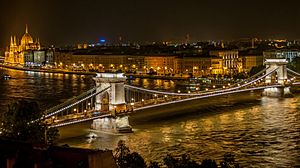
Hungary has 3,152 local areas called municipalities. As of July 15, 2013, there are 346 towns and 2,806 villages. These cover the whole country. The number of towns can change. Villages can become towns by a decision from the president. Budapest has a special status. It is not part of any county.
23 of the towns are called urban counties. These are "towns with county rights". They have more powers. All county seats, except Budapest, are urban counties. Four cities have large city areas: Budapest, Miskolc, Győr, and Pécs. The Hungarian Statistical Office also lists seventeen other areas that are growing into city areas. Budapest is the largest city. There are over 100 villages with fewer than 100 people. The smallest villages have fewer than 20 people.
Hungary's Economy
Hungary has a strong mixed economy. It is an OECD high-income country. It has a very high human development index. This means people generally have a good quality of life. Hungary also has a skilled workforce. It has the 16th lowest income inequality in the world. This means wealth is shared more evenly. It is also the 9th most complex economy.
The economy is the 57th largest in the world. Its total output was $265.037 billion. It ranks 49th in the world for GDP per person. Hungary's economy relies a lot on foreign trade. It is the 36th largest export economy in the world. In 2015, Hungary exported over $100 billion in goods. It had a trade surplus of $9.003 billion. Most of this trade was with the EU.
More than 80% of Hungary's economy is owned by private businesses. Taxes make up 39.1% of the economy. This helps fund the country's social support system. People's spending is the main part of the country's total economic output. It makes up 50% of the GDP. Business investments are 22%, and government spending is 20%.
Hungary is a top country for attracting foreign direct investment (FDI) in Central and Eastern Europe. In 2015, $119.8 billion was invested in Hungary. Hungary also invested over $50 billion abroad. As of 2015, its main trading partners were Germany, Austria, Romania, Slovakia, France, Italy, Poland, and the Czech Republic.
Major industries include:
- Food processing
- Medicines
- Cars
- Information technology
- Chemicals
- Metal production
- Machinery
- Electrical goods
- Tourism (with 12.1 million international tourists in 2014)
Hungary is the biggest electronics producer in Central and Eastern Europe. Electronics manufacturing and research drive innovation and economic growth. In the last 20 years, Hungary has also become a major center for mobile technology and information security.
The number of people working was 68.3% in 2017. Most workers (63.2%) are in the service sector. Industry makes up 29.7% of jobs, and agriculture 7.1%. The unemployment rate was 4.1% in 2017. This was down from 11% during the 2007–2008 financial crisis. Hungary is part of the European single market. This market has over 508 million consumers. Many business rules are set by agreements among EU members.
Large Hungarian companies are part of the BUX, the stock market index in Budapest. Well-known companies include MOL Group, OTP Bank, and Magyar Telekom. Hungary also has many specialized small and medium businesses. These include car parts suppliers and tech start-ups.
Budapest is the financial and business center. It is a major world city. Budapest leads Hungary in business and economy. It accounts for 39% of the national income. The city's total economic output was over $100 billion in 2015. This makes it one of the largest regional economies in the European Union. Budapest is also among the top 100 cities globally for GDP.
Hungary uses its own money, the Hungarian forint (HUF). The Hungarian National Bank focuses on keeping prices stable. Hungary's company tax rate is only 9%. This is quite low for EU countries.
Science and Technology in Hungary
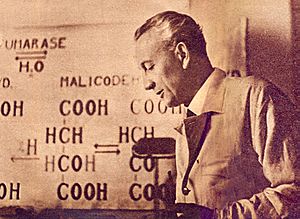
Hungary has made big achievements in science and technology. Research and development are a key part of its economy. In 2020, Hungary spent 1.61% of its total economic output on research and development. This is the 25th highest in the world. Hungary ranks 32nd among the most innovative countries. In 2023, it was 35th in the Global Innovation Index. In 2014, Hungary had 2,651 full-time researchers for every million people. This number has been growing.
Hungary's high-tech industry has benefited from its skilled workers. It also benefits from many foreign high-tech companies and research centers. Hungary also has many patents. It has the sixth highest amount of high-tech products in its total industrial output. It ranks 12th for foreign investment in research. It is 14th for research talent in businesses. It has the 17th best overall innovation efficiency in the world.
The main group for research and development in Hungary is the National Research, Development and Innovation (NRDI) Office. This office plans and funds scientific research. It also advises the government on research policy. It manages the NRDI Fund. It represents Hungary in international science groups.
Science research gets money from businesses and the government. This funding goes to universities and science institutions like the Hungarian Academy of Sciences. Hungary has been home to many famous researchers. They have worked in physics, math, chemistry, and engineering. As of 2018, thirteen Hungarian scientists have won a Nobel Prize.
Hungary has excellent mathematics education. This has trained many great scientists. Famous Hungarian mathematicians include János Bolyai, who helped create non-Euclidean geometry. Paul Erdős was known for publishing many papers. John von Neumann was important in quantum mechanics and game theory. He was also a pioneer in digital computing. He was the chief mathematician for the Manhattan Project.
Important Hungarian inventions include:
- The lead dioxide match (János Irinyi)
- A type of carburetor (Donát Bánki, János Csonka)
- The electric (AC) train engine and generator (Kálmán Kandó)
- Holography (Dennis Gabor)
- The Kalman filter (Rudolf E. Kálmán)
- Rubik's Cube (Ernő Rubik)
Getting Around: Transport in Hungary
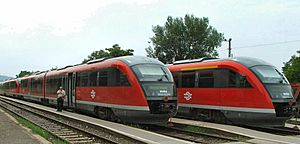
Hungary has a very good system for roads, railways, air, and water transport. Budapest is a major center for the Hungarian State Railways (MÁV). The capital has three large train stations: Keleti (Eastern), Nyugati (Western), and Déli (Southern). Szolnok is the most important railway hub outside Budapest. Other key stations are in Miskolc, Szombathely, Győr, Szeged, and Székesfehérvár.
From March 2024, train travel on the Hungarian railway MÁV will be free for people aged 65 and over, and for those under 14.
Budapest, Debrecen, Miskolc, and Szeged have tram networks. The Budapest Metro is the second-oldest underground train system in the world. Its Line 1 opened in 1896. The system has four lines. A commuter train system, HÉV, runs in the Budapest area.
Hungary has about 1,314 km (816 miles) of motorways. New sections are being added. These roads connect many important cities to the capital. Ports are located in Budapest, Dunaújváros, and Baja.
There are five international airports: Budapest Ferenc Liszt, Debrecen, Hévíz–Balaton, Győr-Pér, and Pécs-Pogány. However, only Budapest and Debrecen have regular flights. The low-cost airline Wizz Air is based at Budapest Ferenc Liszt Airport.
Energy in Hungary
Hungary's energy mostly comes from fossil fuels. Natural gas is the largest source, followed by oil and coal. In June 2020, Hungary passed a law to reach net-zero emissions by 2050. This means balancing the amount of greenhouse gases released with those removed.
As part of this plan, Hungary also updated its National Energy Strategy 2030. It now looks ahead to 2040. The plan focuses on energy that is carbon-neutral and affordable. It also aims to make Hungary more energy secure and independent. Big investments are expected in the power sector. This includes building two new nuclear energy units.
The amount of renewable energy has grown a lot. But in recent years, growth in this area has slowed down. Some rules that limit wind power are expected to hurt the renewable energy sector.
Hungary's release of greenhouse gases has gone down. This is because the economy uses less carbon-based fuels. However, experts say Hungary could set even bigger goals for reducing emissions.
People and Culture of Hungary
Who Lives in Hungary?
In 2021, Hungary's population was 9,689,000. This makes it the fifth most populated country in Central and Eastern Europe. It is a medium-sized member of the European Union. Like other former Eastern Bloc countries, its population has dropped since the end of communism. It was highest at 10.8 million in 1980.
The population density is 107 people per square kilometer. This is about twice the world average. Around 70% of the people live in cities and towns. This is higher than the global average of 56%. One-quarter of Hungarians live in the Budapest metropolitan area.
Like most European countries, Hungary has a low birth rate. Its estimated total fertility rate is 1.43 children per woman. This is below the 2.1 needed to keep the population stable. So, its population has been slowly getting smaller and older. The average age is 42.7 years, which is one of the highest in the world. Many young adults have also moved out of the country.
In 2011, the government started a plan to increase the birth rate among ethnic Magyars. They brought back three-year maternity leave. They also made more part-time jobs available. Since then, the birth rate has slowly gone up. In 2023, the population grew by 0.77%. This was mostly due to immigrants from nearby countries. In 2015, 47.9% of births were to unmarried women.
Life expectancy in 2015 was 71.96 years for men and 79.62 years for women. This has been growing since the fall of Communism.
Hungary recognizes two main minority groups. These are called "national minorities." Their ancestors have lived in Hungary for centuries. There is a German community of about 130,000 people. They live all over the country. There is also a Romani minority of about 300,000. They mainly live in the northern part of Hungary. Some studies suggest there are many more Romani in Hungary (around 876,000 people, or about 9% of the population).
According to the 2011 census:
- 8,314,029 people (83.7%) were Hungarians.
- 308,957 people (3.1%) were Romani.
- 131,951 people (1.3%) were Germans.
- 29,647 people (0.3%) were Slovaks.
- 26,345 people (0.3%) were Romanians.
- 23,561 people (0.2%) were Croats.
1,455,883 people (14.7% of the total population) did not say their ethnicity. Hungarians made up over 90% of those who did state their ethnicity. In Hungary, people can say they belong to more than one ethnic group. So, the total of all ethnic groups can be higher than the total population.
About 5 million Hungarians live outside Hungary.
Languages Spoken in Hungary
Hungarian is the official and most spoken language. It is the 13th most widely spoken first language in Europe. About 13 million people speak it as their native language. It is one of the 24 official languages of the European Union. Outside Hungary, it is also spoken in neighboring countries. Hungarian communities around the world also speak it.
According to the 2011 census, 9,896,333 people (99.6%) speak Hungarian in Hungary. Of these, 9,827,875 people (99%) speak it as their first language. 68,458 people (0.7%) speak it as a second language.
English (1,589,180 speakers, 16.0%) and German (1,111,997 speakers, 11.2%) are the most common foreign languages. Hungary also recognizes several minority languages. These include Armenian, Bulgarian, Croatian, German, Greek, Romanian, Romani, Rusyn, Serbian, Slovak, Slovenian, and Ukrainian.
Hungarian belongs to the Uralic language family. It is not related to any neighboring languages. It is distantly related to Finnish and Estonian. It is the largest Uralic language by number of speakers. It is the only one spoken in Central Europe. Standard Hungarian is based on the language spoken in Budapest. Hungarian has several city and country dialects.
Religion in Hungary
Hungary is a country with a Christian past. Hungarian history says the Hungarian state began when Stephen I was baptized and crowned in A.D. 1000. He made Catholicism the official religion. His successors were known as the Apostolic Kings. The Catholic Church in Hungary stayed strong for centuries. The Archbishop of Esztergom had special powers as the main religious leader.
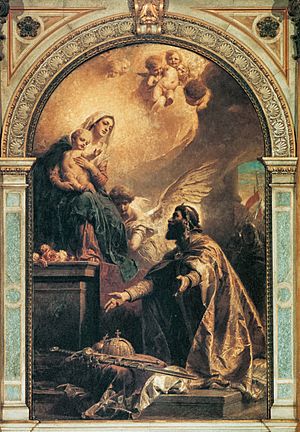
Today, Hungary has no official religion. It allows freedom of religion. But the constitution says it "recognizes Christianity's nation-building role." It also says the state can work with churches for community goals. The 2022 census showed that 42.5% of Hungarians were Christians. Most of them were Roman Catholics (27.5%) and Hungarian Reformed Calvinists (9.8%). There were also Lutherans (1.8%), Greek Catholics (1.7%), and other Christians (1.7%).
Small groups include Jewish (0.1%), Buddhist (0.1%) and Islamic (0.1%) communities. 40.1% of people did not say their religion. 16.1% said they had no religion.
During the start of the Protestant Reformation, most Hungarians became Lutheran, then Calvinist. In the late 1500s, the Jesuits led a movement to bring people back to Catholicism. This worked partly. But Hungarian nobles, mostly Reformed, were able to get religious freedom for Protestants. This meant that each local area often followed the religion of its ruler. So, many places in Hungary are still known as historically Catholic, Lutheran, or Reformed. Eastern Hungary, especially around Debrecen, is almost completely Reformed. This is also true for Hungarian areas across the Romanian border. Orthodox Christianity in Hungary is linked to ethnic minorities. These include Armenians, Bulgarians, Greeks, Romanians, Rusyns, Ukrainians, and Serbs.
Historically, Hungary had a large Jewish community. Before World War II, there were over 800,000 Jews. But it is thought that over 564,000 Hungarian Jews were killed during the Holocaust between 1941 and 1945. Between May 15 and July 9, 1944, over 434,000 Jews were sent away. Of the over 800,000 Jews in Hungary from 1941–1944, about 255,500 are thought to have lived. Today, there are about 120,000 Jews in Hungary.
Education in Hungary
Education in Hungary is mostly public. It is run by the Ministry of Education. Preschool or kindergarten is required for all children aged three to six. After that, school is required until age sixteen. Primary education usually lasts eight years. Secondary education has three main types of schools:
- The Gymnasium is for the most talented students. It prepares them for university.
- Secondary vocational schools are for intermediate students and last four years.
- Technical schools prepare students for vocational education and work.
The system is somewhat flexible, and students can move between types of schools. A study found that 13–14-year-old students in Hungary were among the best in the world for math and science.
Most universities are public institutions. Students traditionally do not pay fees. To get into university, students usually need to pass the Matura exam. Hungary's public higher education system includes universities and other schools. They offer degrees up to doctoral level. They also do research. Health insurance for students is free until they finish their studies.
English and German are important languages in Hungarian higher education. Many degree programs are taught in these languages. This attracts thousands of exchange students each year. Hungary's higher education and training ranked 44th out of 148 countries in a 2014 report.
Hungary has a long history of higher education. Several universities are among the oldest in the world. These include the University of Pécs (founded 1367) and Óbuda University (1395). The Eötvös Loránd University was founded in 1635 and moved to Buda in 1777. The world's first institute of technology was founded in Selmecbánya in 1735. Its successor is the University of Miskolc. The Budapest University of Technology and Economics is considered the oldest institute of technology with university status. It was founded in 1782.
Hungary ranks fourth in the total number of medals won at the International Mathematical Olympiad. This is since 1959.
Healthcare in Hungary

Hungary has a universal health care system. The government's national health insurance mostly pays for it. According to the OECD, 100% of the people are covered by universal health insurance. It is free for children, students, and older people. It is also free for people with low income, disabled people, and church workers.
Hungary spends 7.2% of its GDP on healthcare. It spends $2,045 per person. Of this, $1,365 comes from the government.
Hungary is a top place for medical tourism in Europe. This is especially true for dentistry. Hungary handles 42% of dental tourism in Europe and 21% worldwide. Plastic surgery is also a key area. 30% of clients come from other countries. Hungary is known for its spa culture. It has many medicinal spas. These attract "spa tourism."
Hungary is ranked as the 17th safest country in the world.
Hungarian Culture
Architecture in Hungary
Hungary is home to some amazing buildings. It has the largest synagogue in Europe. It was built in 1859 in a Moorish Revival style. It can hold 3,000 people. Hungary also has the largest medicinal bath in Europe. It was finished in 1913 in a Modern Renaissance style. It is in the Budapest city park.
Other notable buildings include one of the largest basilicas in Europe. There is also the second-largest territorial abbey in the world. And the largest early Christian burial site outside Italy.
Important architectural styles include Historicism and different types of Art Nouveau. Hungarian Art Nouveau is special because it uses national building features. Ödön Lechner, a key figure in Hungarian Art Nouveau, was inspired by Indian and Syrian buildings. He also used traditional Hungarian designs. He mixed these ideas to create a unique style. He applied these to building parts. This made a version of Art Nouveau that was unique to Hungary.
Some architects, like Károly Kós, used traditional Hungarian building shapes. They wanted to achieve the same unique style. Budapest also shows styles from other European countries. You can see influences from Vienna, Germany, Belgium, France, England, and Finland. These are in buildings from the early 1900s.
In downtown Budapest, most buildings are about one hundred years old. They have thick walls, high ceilings, and designs on their fronts.
Music in Hungary
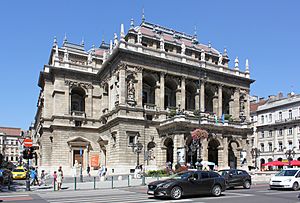
Hungarian music includes traditional Hungarian folk music. It also features music by famous composers like Franz Liszt and Béla Bartók. They are considered among the greatest Hungarian composers. Other well-known composers are Ernst von Dohnányi, Zoltán Kodály, and Miklós Rózsa. Hungarian traditional music often has a strong rhythm. This is because the Hungarian language usually stresses the first syllable of each word.
Hungary has famous composers of modern classical music. These include György Ligeti and György Kurtág. Bartók was one of the most important musicians of the 20th century. His music used themes and rhythms from Hungarian and nearby folk music. He combined these with ideas from other composers to create his own style.
Folk music is a big part of Hungary's national identity. It has been important in areas that are now part of other countries. These include Romania, Slovakia, and Poland. This is especially true in southern Slovakia and Transylvania. After a music academy was started by Liszt and Ferenc Erkel, Hungary produced many great musicians.
Some famous Hungarian musicians include:
- Pianists: Ernő von Dohnányi, Tamás Vásáry, András Schiff, Zoltán Kocsis.
- Violinists: Joseph Joachim, Leopold Auer, Joseph Szigeti.
- Conductors: Eugene Ormandy, George Szell, Sir Georg Solti.
- String Quartets: Budapest Quartet, Takács Quartet.
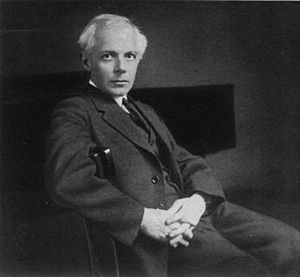
Some say that Hungarian music has influenced nearby countries. This might be because of their shared history with Austria-Hungary. It is common to hear Hungarian-sounding tunes in Romania, Slovakia, and Poland. Folk music is also strong in the Szabolcs-Szatmár area and in Transdanubia, near Croatia. The Busójárás carnival in Mohács is a big Hungarian folk music event.
Hungarian classical music has long tried to create a unique style. It uses Hungarian folk songs as a base. Even though the Hungarian upper class had ties with Europe, rural farmers kept their traditions. By the late 1800s, Hungarian composers could use this folk music. They used it to create a Hungarian classical style. For example, Bartók collected folk songs from across Central and Eastern Europe. Kodály was more interested in creating a clearly Hungarian musical style.
During communist rule, a committee checked popular music. They looked for anything against the government. Since then, the Hungarian music industry has gotten better. It has produced successful jazz artists. These include trumpeter Rudolf Tomsits. Modern Hungarian folk music artists like Ferenc Sebő and Márta Sebestyén are also popular.
The three big Hungarian rock bands are Illés, Metró, and Omega. They are still very popular. Omega is also popular in Germany and other countries. Older underground bands like Beatrice from the 1980s are still liked.
Literature in Hungary

In ancient times, Hungarian was written with a runic-like script. But it wasn't used for modern literature. The country switched to the Latin alphabet in the 11th century. This happened after Hungary became Christian under King Stephen I. The oldest Hungarian writing we still have is a small piece from a document in 1055. It has a few Hungarian words, like "up the military road to Fehérvár." The rest of the document was in Latin.
The oldest full text in Hungarian is the Funeral Sermon and Prayer (1192–1195). It is a translation of a Latin sermon. The oldest Hungarian poem is the Old Hungarian Lamentations of Mary. It is also a translation from Latin, from the 13th century. It is the oldest surviving Uralic poem.
Some of the first books about Hungarian history were Gesta Hungarorum (Deeds of the Hungarians) by a writer known as Anonymus. Another was Gesta Hunnorum et Hungarorum (Deeds of the Huns and the Hungarians) by Simon Kézai. Both were in Latin. These books mix history with legends, so they are not always fully accurate. Another important book is the Képes krónika (Illustrated Chronicle). It was written for Louis the Great.
Renaissance literature grew under King Matthias. Janus Pannonius wrote in Latin. But he is seen as a very important Hungarian writer. He was the only major Hungarian Humanist poet of that time. The first printing press was also started during Matthias's rule. It was by András Hess in Buda. The first book printed in Hungary was the Chronica Hungarorum.
The most important poets of that time were Bálint Balassi and Miklós Zrínyi. Balassi's poems show medieval influences. His poems are about love, war, and religion. Zrínyi's most famous work is the epic poem Szigeti veszedelem (The Peril of Sziget). It was written in 1648/49. It is like the Iliad. It tells the story of the heroic Siege of Szigetvár. His great-grandfather died defending the castle there.
Among religious writings, the most important is the Bible translation by Gáspár Károlyi. He was a Protestant pastor. His translation in 1590 was the second Hungarian Bible translation. It is called the Bible of Vizsoly, after the town where it was first printed.
The Hungarian Enlightenment happened about 50 years after the French Enlightenment. The first writers of this period were bodyguards of Maria Theresa. The greatest poets were Mihály Csokonai and Dániel Berzsenyi. Ferenc Kazinczy was the most important person in reforming the Hungarian language. From this time, Hungarian became suitable for all kinds of scientific explanations. Many new words were also created for new inventions.
Hungarian literature has recently become more known outside Hungary. This is mostly through translations into German, French, and English. Some modern Hungarian authors are very popular in Germany and Italy. These include Sándor Márai, Péter Esterházy, and Imre Kertész. Imre Kertész is a Jewish writer who survived the Holocaust. He won the Nobel Prize for literature in 2002.
Older Hungarian classics and poetry are still mostly unknown outside Hungary. János Arany, a famous 19th-century Hungarian poet, is still loved in Hungary. His collection of ballads is especially popular. Other "true classics" include Sándor Petőfi, the poet of the 1848 Revolution. Also, Endre Ady, Attila József, and Miklós Radnóti. Other well-known Hungarian authors are Mór Jókai, Frigyes Karinthy, and Magda Szabó.
Hungarian Food and Drink
Traditional dishes like the famous goulash (a stew or soup) are very important in Hungarian cooking. Dishes often use paprika (ground red peppers). This was a Hungarian invention. Paprika powder, made from a special pepper, is a very common spice. Thick, sour cream called tejföl is often used. It makes the flavor of a dish milder. The famous Hungarian hot fish soup, halászlé, is usually a rich mix of different cooked fish.
Other dishes include chicken paprikash. There is also foie gras made from goose liver. Pörkölt is a stew. Vadas is a game stew with vegetable gravy and dumplings. There are also trout with almonds and salty and sweet dumplings. An example is túrós csusza, which are dumplings with fresh quark cheese and thick sour cream.
Desserts include the famous Dobos torte. There are also strudels (rétes), filled with apple, cherry, poppy seed, or cheese. Other desserts are Gundel pancake and plum dumplings (szilvás gombóc). There are also somlói dumplings. Dessert soups like chilled sour cherry soup are popular. Sweet chestnut puree, gesztenyepüré, is also a favorite. It is cooked chestnuts mashed with sugar and rum, topped with whipped cream. Perec and kifli are popular baked goods.
The csárda is a unique type of Hungarian inn. It is an old-style tavern that serves traditional food and drinks. A borozó is a cozy old wine tavern. A pince is a beer or wine cellar. A söröző is a pub that serves draft beer and sometimes food. A bisztró is a cheap restaurant, often self-service. A büfé is the cheapest place, where you might eat standing at a counter. Pastries, cakes, and coffee are served at a cukrászda (confectionery). An eszpresszó is a café.
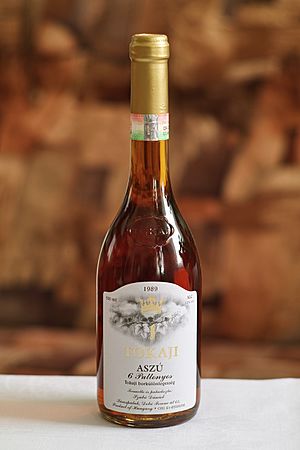
Pálinka is a fruit brandy. It is made from fruit grown in orchards on the Great Hungarian Plain. It is a spirit native to Hungary. It comes in flavors like apricot and cherry. But plum is the most popular flavor. Beer goes well with many traditional Hungarian dishes. The five main Hungarian beer brands are Borsodi, Soproni, Arany Ászok, Kõbányai, and Dreher. People traditionally do not clink their glasses when drinking beer. There is a story that Austrian generals clinked their beer glasses to celebrate the execution of 13 Hungarian leaders in 1849. Many people still follow this tradition. But younger people sometimes ignore it, saying the promise was only for 150 years.
Hungary is great for making wine. The country has many wine regions. The Romans brought grapevines to Pannonia. By the 5th century AD, there were many vineyards in what is now Hungary. Hungarians brought their wine-making knowledge from the East. According to a writer named Ibn Rustah, Hungarian tribes knew how to make wine long before they came to the Carpathian Basin.
Different wine regions offer many styles. Hungary's main wines are elegant and full-bodied dry white wines with good acidity. There are also complex sweet white wines (Tokaj). And elegant (Eger) and strong red wines (Villány and Szekszárd). The main grape varieties are:
- Whites: Olaszrizling, Hárslevelű, Furmint, Pinot gris, Chardonnay.
- Reds: Kékfrankos, Kadarka, Portugieser, Zweigelt, Cabernet Sauvignon, Cabernet Franc, and Merlot.
The most famous Hungarian wines are Tokaji Aszú and Egri Bikavér. Tokaji wine has been praised by many great writers and composers.
For over 150 years, a mix of forty Hungarian herbs has been used to make unicum. This is a bitter, dark liqueur. It can be drunk before or after a meal.
Folk Art in Hungary
Ugrós (jumping dances) are old dances from the Middle Ages. These can be solo or couple dances with old-style music. They include shepherd dances and other solo men's dances from Transylvania. There are also marching dances and old weapon dances. Karikázó is a circle dance performed by women. They sing folk songs while dancing.
Csárdás are newer dances. They developed in the 18th and 19th centuries. They feature embroidered costumes and lively music. From men's fancy boot-slapping dances to old women's circle dances, Csárdás shows the fun of Hungarian folk dancing. This dancing is still celebrated in villages. Verbunkos is a solo men's dance. It came from the recruiting shows of the Austro-Hungarian army. The legényes is a men's solo dance. It is done by ethnic Hungarian people in the Kalotaszeg region of Transylvania. Young men usually dance it, but older men can too. The dance is usually done freely by one dancer at a time in front of a band. Women join in by standing in lines to the side. They sing or shout verses while the men dance. Each man performs several dance moves, usually four to eight, without repeating. Each move has four parts, each lasting four counts. The first part is usually the same for everyone.
In the early 18th century, the current style of Hungarian folk art began. It included elements from the Renaissance and Baroque periods. It also had influences from Persian Sassanid art. Flowers and leaves are the main decorations. Sometimes a bird or a spiral design is used. The most common decoration is a flower that looks like a peacock's feather. Almost all types of folk art found in Europe also existed among Hungarian farmers at some point. Their ceramics and textiles are the most developed.
The best textile art is their embroidery. It changes from region to region. The embroideries from Kalotaszeg are beautiful. They have Oriental designs. They are mostly sewn in one color: red, blue, or black. The designs are soft and used on altar cloths, pillowcases, and sheets.
The Sárköz and Matyóföld regions make the finest embroideries. Women's caps often have black and white designs. These are as delicate as lace. They show the people's wonderful artistic skill. The embroidery designs used on women's clothes are also put on tablecloths and runners. These can be used as wall decorations today.
Sports in Hungary
Hungarian athletes have done very well in the Summer Olympic Games. Hungary ranks 9th with a total of 511 medals in the all-time Summer Olympic Games medal count. Hungary has the third-highest number of Olympic medals per person. It has the second-highest number of gold medals per person in the world.
Hungary has always been excellent in Olympic water sports. In water polo, the men's Hungarian team has won the most medals by far. In swimming, both the men's and women's teams are the fifth most successful. Hungary leads in total medals for canoeing and kayaking. Hungary won its first Winter Olympics gold medal in 2018. This was in men's short track speed skating. The team had four members: Csaba Burján, Shaolin Sándor Liu, Shaoang Liu, and Viktor Knoch.
Hungary has hosted many big sports events. These include the 1997 World Amateur Boxing Championships and the 2000 World Fencing Championships. In the last two decades, it also hosted the 2017 World Aquatics Championships and the 2017 World Judo Championships. Besides these, Hungary hosted many European-level tournaments. It also hosted 4 matches in the UEFA Euro 2020. These were held in the new 67,889-seat Puskás Ferenc Stadium.
Hungary has won three Olympic football titles. Hungary changed football in the 1950s. They created the ideas for total football. They were a dominant force in international football with the Aranycsapat ("Golden Team"). This team included Ferenc Puskás. He was the top goal scorer of the 20th century. FIFA named its newest award, the Puskás Award, after him. That team had the second highest Football Elo Rating ever. They also had one of the longest unbeaten streaks in football history. They were unbeaten in 31 games over more than four years. After this "golden age," Hungary's football became weaker. But recently, things are improving. The Hungarian Children's Football Federation was founded in 2008. Youth development is growing. Hungary hosted the 2010 UEFA Futsal Championship in Budapest and Debrecen. This was the first time the MLSZ hosted a UEFA finals tournament.
The Hungarian Grand Prix in Formula One is held at the Hungaroring. This track is just outside Budapest. It has a top license from the FIA. Since 1986, the race has been part of the Formula One World Championship. The track was completely redone in early 2016. The Grand Prix deal was extended for five more years, until 2026.
Chess is a popular and successful sport in Hungary. Hungarian players are the eighth strongest overall in the World Chess Federation rankings. There are about 54 Grandmasters and 118 International Masters. This is more than in France or the United Kingdom. Judit Polgár is often seen as the strongest female chess player of all time. Some of the world's best sabre athletes have also come from Hungary. In 2009, the Hungary men's national ice hockey team qualified for their first IIHF World Championship. In 2015, they qualified for their second top-division world championship.
See also
 In Spanish: Hungría para niños
In Spanish: Hungría para niños
- Outline of Hungary
- Index of Hungary-related articles
- Hungary at the Olympics
- Hungary national football team
- List of rivers of Hungary
Images for kids
-
King Saint Stephen, the first King of Hungary, converted the nation to Christianity.
-
The Holy Crown (Szent Korona), one of the key symbols of Hungary
-
A map of the lands ruled by Louis the Great in Pallas's Great Encyclopedia
-
Map of the lands ruled by Matthias Corvinus. Designed by Dr. Lajos Baróti.
-
Francis II Rákóczi, leader of the war of independence against Habsburg rule in 1703–11
-
Count István Széchenyi offered one year's income to establish the Hungarian Academy of Sciences.
-
Lajos Kossuth, Regent-President during the Hungarian Revolution of 1848
-
Coronation of Francis Joseph I and Elisabeth Amalie at Matthias Church, Buda, 8 June 1867
-
With the Treaty of Trianon, Hungary lost 72% of its territory, its sea ports and 3,425,000 ethnic Hungarians Majority Hungarian areas (according to the 1910 census) detached from Hungary
-
Miklós Horthy, Regent of the Kingdom of Hungary (1920–1944)
-
A destroyed Soviet tank in Budapest during the Revolution of 1956. Time's Man of the Year for 1956 was the Hungarian freedom fighter.
-
Albert Szent-Györgyi won the Nobel Prize in Physiology or Medicine for his discovery of Vitamin C. The Nobel Prize has been awarded to 13 Hungarians.
-
Siemens Desiro passenger trains on the Hungarian State Railways network, which is one of the densest in the world.
-
King Saint Stephen offering the Hungarian crown to Virgin Mary – painting by Gyula Benczúr, in the St. Stephen's Basilica
-
Rector's Council Hall of Budapest Business School, the first public business school in the world, founded in 1857
-
The Museum of Applied Arts, an Art Nouveau building designed by Ödön Lechner
-
The Hungarian State Opera House on Andrássy út (a World Heritage Site)
-
Ferenc Liszt, one of the greatest pianists of all time; a renowned composer and conductor
-
Béla Bartók, a composer of great influence in the early 20th century; one of the founders of ethnomusicology
-
Sándor Petőfi, Hungarian poet and revolutionary
-
Ferenc Puskás, the greatest top division scorer of the 20th century. The FIFA Puskás Award is named in his honour.




